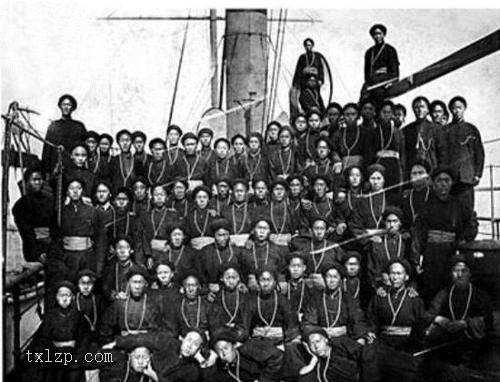Period:Unknown Production date:3rdC
Materials:fired clay
Technique:moulded, burnished, incised, 雕刻 (Chinese),
Subjects:mammal
Dimensions:Height: 4.60 centimetres Width: 1.80 centimetres Depth: 2 centimetres
Description:
Fragment of a figurine made of fired red clay, possibly burnished. It is the upper part of a monkey, holding a water skin to its breast with the left arm, right arm missing.The monkey wears a conical hat decorated with a pattern of parallel running incised lines. The pointy end of the hat is elongated and falls to the waist.
IMG
![图片[1]-figure BM-MAS.230-China Archive](https://chinaarchive.net/Unknown/43/mid_01069429_001.jpg)
![图片[2]-figure BM-MAS.230-China Archive](https://chinaarchive.net/Unknown/43/mid_01069431_001.jpg)
![图片[3]-figure BM-MAS.230-China Archive](https://chinaarchive.net/Unknown/43/mid_01069436_001.jpg)
![图片[4]-figure BM-MAS.230-China Archive](https://chinaarchive.net/Unknown/43/mid_01069439_001.jpg)
Comments:Ak-terekMain publication: Stein 1921a, 133-141; for object descriptions see passim, 141-152Date: 4th-7th cent. ADThe site of Akterek lies near the modern city of Khotan. Here, from 18th-21st of September 1906 Aurel Stein excavated a Buddhist cella with an adjoining passage extending around the four walls. At first, no structural remains such as temple walls were visible above ground (Stein 1921a, 134), but these were eventually discovered through digging trial trenches. Even before that, a large number of fragments from Buddhist sculpture such as “(…) fragments of ears, fingers, toes, noses and other parts of the body” (Stein 1921a, 138) as well as parts of halos, vesicas etc. were found.The finds proved to be stylistically identical to those from Rawak discovered in 1901 (Stein 1907,482-488), which made Stein draw the conclusion that the Ak-terek shrine must be roughly contemporaneous with the Rawak stupa. The main difference between the finds from both sides though, was that the objects from Rawak consisted of friable stucco while the ones from Ak-terek were made of hard-baked terracotta. This, as well as the finding of fragments of completely charred wood, lead Aurel Stein to the conclusion that the cella had first been destroyed by fire before gradually decaying. (for further information see Stein 1921a, 136)Other finds were figurines similar to the ones from Yotkan, which according to Stein were of special interest as they “furnish the first definitive evidence as to the period when this branch of old Khotan art flourished.” (Stein 1921a, 137)Key to Aurel Stein’s numbering system for Ak-terek site:A.T. 001-00xx = finds picked up on eroded ground close to the shrineA.T. i. = central part of the north passageA.T. ii. = east corner of the north passageA.T. iii. = west corner of the north passage A.T. iv. = ? (no explanation in text)A.T. v. = west passage of the temple For further information on Stein’s site-mark numbering system see Stein 1921a, p. xv, fn 16
Materials:fired clay
Technique:moulded, burnished, incised, 雕刻 (Chinese),
Subjects:mammal
Dimensions:Height: 4.60 centimetres Width: 1.80 centimetres Depth: 2 centimetres
Description:
Fragment of a figurine made of fired red clay, possibly burnished. It is the upper part of a monkey, holding a water skin to its breast with the left arm, right arm missing.The monkey wears a conical hat decorated with a pattern of parallel running incised lines. The pointy end of the hat is elongated and falls to the waist.
IMG
![图片[1]-figure BM-MAS.230-China Archive](https://chinaarchive.net/Unknown/43/mid_01069429_001.jpg)
![图片[2]-figure BM-MAS.230-China Archive](https://chinaarchive.net/Unknown/43/mid_01069431_001.jpg)
![图片[3]-figure BM-MAS.230-China Archive](https://chinaarchive.net/Unknown/43/mid_01069436_001.jpg)
![图片[4]-figure BM-MAS.230-China Archive](https://chinaarchive.net/Unknown/43/mid_01069439_001.jpg)
Comments:Ak-terekMain publication: Stein 1921a, 133-141; for object descriptions see passim, 141-152Date: 4th-7th cent. ADThe site of Akterek lies near the modern city of Khotan. Here, from 18th-21st of September 1906 Aurel Stein excavated a Buddhist cella with an adjoining passage extending around the four walls. At first, no structural remains such as temple walls were visible above ground (Stein 1921a, 134), but these were eventually discovered through digging trial trenches. Even before that, a large number of fragments from Buddhist sculpture such as “(…) fragments of ears, fingers, toes, noses and other parts of the body” (Stein 1921a, 138) as well as parts of halos, vesicas etc. were found.The finds proved to be stylistically identical to those from Rawak discovered in 1901 (Stein 1907,482-488), which made Stein draw the conclusion that the Ak-terek shrine must be roughly contemporaneous with the Rawak stupa. The main difference between the finds from both sides though, was that the objects from Rawak consisted of friable stucco while the ones from Ak-terek were made of hard-baked terracotta. This, as well as the finding of fragments of completely charred wood, lead Aurel Stein to the conclusion that the cella had first been destroyed by fire before gradually decaying. (for further information see Stein 1921a, 136)Other finds were figurines similar to the ones from Yotkan, which according to Stein were of special interest as they “furnish the first definitive evidence as to the period when this branch of old Khotan art flourished.” (Stein 1921a, 137)Key to Aurel Stein’s numbering system for Ak-terek site:A.T. 001-00xx = finds picked up on eroded ground close to the shrineA.T. i. = central part of the north passageA.T. ii. = east corner of the north passageA.T. iii. = west corner of the north passage A.T. iv. = ? (no explanation in text)A.T. v. = west passage of the temple For further information on Stein’s site-mark numbering system see Stein 1921a, p. xv, fn 16
© Copyright
The copyright of the article belongs to the author, please keep the original link for reprinting.
THE END



![[Qing Dynasty] British female painter—Elizabeth Keith, using woodblock prints to record China from the late Qing Dynasty to the early Republic of China—1915-China Archive](https://chinaarchive.net/wp-content/uploads/2022/11/image-191x300.png)

